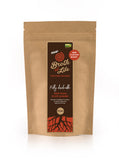Food manufacturers have realised consumers are becoming more interested in bone broth as it gains popularity as the next big “superfood”. These manufacturers know as long as you see the words BONE and BROTH on the label you’ll assume the product is good for your health. And most consumers do fall for this trick!
But there is a problem. No only do consumers need to know how to read labels on food, there are also the hidden ingredients that are not required to be on labels and questionable processes that may take place. This can make choosing the right broth for you rather tricky!
In this blog I want to outline some key things a purchaser should look for when buying bone broth.
1. Ingredients must be certified organic
I've written a
blog dedicated to the reasons why bone broth must be made with certified organic bones. You see, for us to gain maximum benefit from drinking bone broth, the animal from which the bones came must be healthy. Feed lot cattle are given hormones, antibiotics and are fed an unnatural diet. Bones, and especially the marrow, hold all the toxins from this treatment and this will be coming through into your bone broth. If it is not organic, you may well be doing more harm than good!
2. Product must not contain fillers
Dangerous ingredients are often hidden as innocent sounding names. A common example is yeast extract, which is in fact another name for monosodium glutamate, best known as MSG. This chemical taste enhancer is well known for enhancing flavour and is often used in place of real foods. You most certainly don't want this potentially harmful additive in your broth.
Another common additive is maltodexterin, something we were personally approached to add to our product as a thickener and shelf life extender. Maltodexterin comes from a hydrolised starch, usually corn, rice, wheat or potato. After processing it becomes a form of corn syrup solid, but with less than 20% sugar content. In brief it is an easily absorbed carbohydrate in the form of sugar. This can be added to a bone broth, and if the percentage is low enough, it is not required on the label. If the source is organic, it too fits under the organic status. To learn more, read our article
The Dangers of Maltodextrin.
Anti caking agents are also common in powdered bone broths. This additive will stop clumping and moisture from building in the dried product giving it a nice even fine texture to the eye. Once again, if a small enough quantity is used, this does not need to be declared on your food label. Check to see if your product looks natural. Does it look like something you could produce at home?
3. Ingredients list does not contain contaminants
There is no requirement for food ingredient lists to include names of chemical contaminants and toxic substances such as BPA and heavy metals found in food.
Simple processes such as receiving mass market pre cut vegetables as an ingredient require that those vegetables be washed via water flume immediately after processing to prevent bacteria. This involves water disinfection and sanitisation, often with the use of chlorine or other chemical. Pre cut fruit and vegetables are often dipped in further treatments to extend shelf life, prevent food turning brown and leave vegetables appearing fresh and natural. Again, there is no need to mention this on a food label.
The simple process of storing hot bone broth can also become a challenge as Food Standards Australia will pass the use of Food Grade plastic tubs to be used for cooling and storing processes. Research is showing when you heat plastics they naturally degrade and can then be responsible for endocrine disruptors.
4. Padding the ingredient list
Another trick is to add ingredients with a positive reputation but in miniscule amounts so they help the ingredient list look amazing. These ingredients are usually additional herbs or superfoods, but in such small quantities, they would have no impact on your health. Also be sure to look out for "natural" flavourings and "natural" colourings along with "added vitamins". All of these are man made and synthesized.
5. Don't be fooled by the name of the product
A food manufacturer can name a product anything they like, regardless of what the actual product is. This means many stock products have been labelled as bone broth, despite very different cooking methods and ingredients. You can read more about the differences between stock and bone broth
here, but buyer beware, bone broth is a very different product with a very different taste and healing properties to stock.
As you can see, this is just a small snippet of what goes on behind the closed doors of food manufacturers. Technology takes over nature and allows for short cuts and massive savings. There is so little the consumer knows when simply looking at a label on some packaged food.
It is our core value and belief that what we produce at Broth of Life is nothing but real food. Our factory pantry and fridge contain ingredients you would easily find in yours. We are never trying to find a short cut, and alternative ingredients. We are never trying to cut an ingredient to find a replacement that will boost flavour. We are not concerned with the kilojoule count on your label. We are not going to add things to extend shelf life. We don't ask what we can add to make the product more visually appealing. We promise to use nothing but pure, organic, in their original form ingredients. Everything is transparent. Everything is natural. Everything is unprocessed.
BUY BONE BROTH

BUY FULLY DISSOLVING BONE BROTH POWDER


